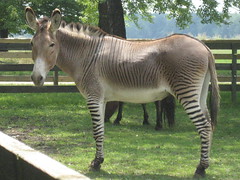 Tonight we went through the next two chapters of Basic Arithmetic (see Ability to Classify for the previous two).
Tonight we went through the next two chapters of Basic Arithmetic (see Ability to Classify for the previous two).
We were confronted with the question, how do we group animals together? The style of the exercises forces one to such a conclusion, as they first try to get us to group animals together without knowledge of the concept of species, and see how hard a time we have of it. Our group, of university-educated adults, spent a fair bit of time on those questions, although partly because we didn’t have intricate knowledge of the difference between dogs and other similar species. We’ll have to do our research next time, before the class!
 So after struggling with which characteristics are shared by dogs and which aren’t, the concept of species was explained in more detail, and some more set related exercises. Species was defined as animals that can cross and produce offspring with the same characteristics as themselves. Then, reflection on interactions between species. I can already see that the reflection sections of this book try to connect the study of the basic science in question to social and spiritual concepts. In this case, talk of mutualism between species, with the heart-warming example of the symbiosis between the clown fish and the sea anemone – where the bright clown fish attracts predators to the anemone, which with its poisonous tentacles paralyses, traps and eats the predator, with the clown fish feasting on the scraps. The rub here is that the clown fish is immune to the anemone’s poison. Anyway, talk of mutualism echoed to me the spiritual principle of unity in diversity, how diverse species can come together for a common purpose.
So after struggling with which characteristics are shared by dogs and which aren’t, the concept of species was explained in more detail, and some more set related exercises. Species was defined as animals that can cross and produce offspring with the same characteristics as themselves. Then, reflection on interactions between species. I can already see that the reflection sections of this book try to connect the study of the basic science in question to social and spiritual concepts. In this case, talk of mutualism between species, with the heart-warming example of the symbiosis between the clown fish and the sea anemone – where the bright clown fish attracts predators to the anemone, which with its poisonous tentacles paralyses, traps and eats the predator, with the clown fish feasting on the scraps. The rub here is that the clown fish is immune to the anemone’s poison. Anyway, talk of mutualism echoed to me the spiritual principle of unity in diversity, how diverse species can come together for a common purpose.
Next, Genus. I keep thinking “add an I to make genius” – but that’s off-topic. As we talk about species, we are asked to compare species and decide which ones are similar. This, larger set of species, can be called a genus. Frankly, I had never heard of this concept, or maybe forgotten a one-off mention in some class in high school. For genus and species names we use latin words, because it is a dead language. So Canis would be the genus of dogs, wolves, jackals, etc. I guess that’s where canine comes from.
Some more set-related exercises involving species and genus as sets and subsets of each other, the concept of a hybrid was introduced (animals of different species can sometimes cross producing one with different characteristics, who can’t reproduce) – and there was some joking among our group trying to come up with names for hybrids such as a wog (wolf-dog), jion (lion-jaguar) etc. Then, my favorite the reflection questions. This time the concept of commensalism where one species benefits from a second, while the second is neither benefited nor harmed by the first. Examples for both this and mutualism were hard to come by as we weren’t really experts in animals and their habits, but we could tell that a random sampling of National Geographic TV would supply us with ample examples. What struck out to me was how this concept of commensalism could be related to tolerance, while mutualism could be cooperation or love – the parallels between patterns of nature and the names and attributes of God.
I’ll be preparing for the next class by reading through the next two chapters, Family and Order, and doing any necessary research to be able to better answer the questions in the group setting. The genius (not genus) of this text unfolds as we progress through it, and you can see how the different spheres of knowledge are woven together so as the student goes through this text, they get a wholistic education and see the inter-relations between the branches of knowledge, as well as see their applications to real-life phenomena.


2 Comments
Lessan!
I have been thinking about the way these texts elucidate on the spiritual principle of Harmony between science and religion and interweave the concepts together….
happy researching! I’ll do some research as well 🙂
until next week..
Thank you for sharing your thoughts. I truly appreciate your efforts
and I will be waiting for your further post thank you once again.